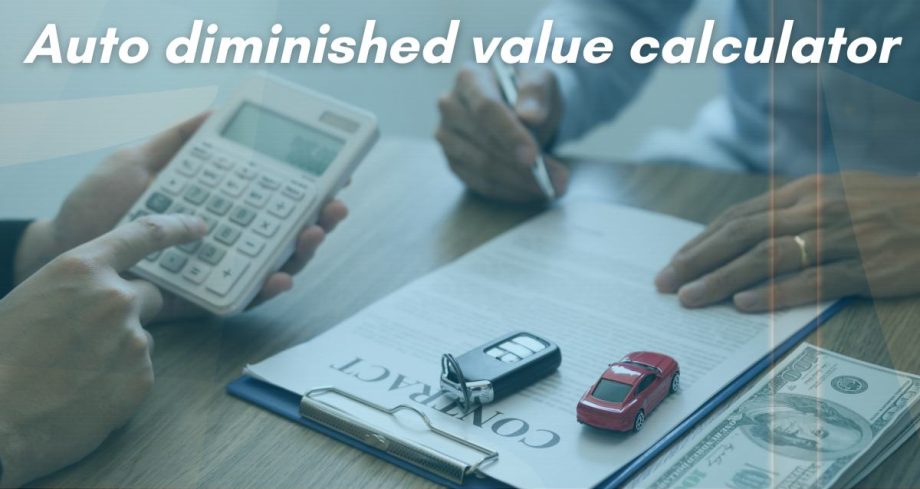Once you take your car off the lot, it starts to lose value, and it will keep losing value over time. However, the value drops a lot after an accident, even if you fix the car up to how it was before. That’s what it means for something to lose value. What is diminished value? What types of diminished value exist? How do you figure it out? How do you make a diminished value claim?
Table of Contents
What Is Diminished Value?
When you have an accident with your car, its value goes down. The background of your car will show that it has been in an accident if you decide to sell it or trade it in for another car. This will make your car worth less when you sell it. The value that has been lost is called the reduced value. It’s the difference between how much your car was worth on the market before and after the accident.
So, diminished value is not the same as devaluation, which is when the value of your car goes down over time. You may be able to make a diminished value claim, in which case either your insurance company or the insurance company of the driver who caused the accident will pay for the value of your car that was lost.
But it’s important to know the different kinds of reduced value before you file a claim for diminished value.

Types Of Diminished Value
There are three different kinds of lost value: inherent, instant, and repair-related.
- Inherent Diminished Value: Inherent diminished value refers to the loss in a car’s market value solely due to its accident history. Even when the vehicle is repaired to a near-perfect state, its history report will still show that it has been in an accident, which can reduce its appeal and market value to potential buyers. As a result, inherent diminished value claims are the most frequently filed and commonly accepted form of diminished value claim with insurance companies, as the accident history itself affects a vehicle’s marketability and resale value.
- Immediate Diminished Value: The immediate diminished value represents the depreciation in a car’s value right after an accident before any repairs are completed. This form of diminished value reflects the vehicle’s perceived loss in worth immediately following a collision, showing a sudden drop due to visible damage and reduced reliability. Although immediate diminished value may sometimes be used in legal proceedings, insurance companies rarely factor this type of diminished value into standard claims, as most cars are repaired promptly following an accident.
- Repair-Related Diminished Value: Repair-related diminished value refers to the reduction in a vehicle’s value due to the quality or completeness of the repairs. If a car is repaired using aftermarket parts or substandard workmanship, it may not be restored to its original value. Visible signs of repair, such as mismatched paint or slight alignment issues, can further affect its market value. To prevent repair-related diminished value, it’s essential to use high-quality repairs and original equipment manufacturer (OEM) parts whenever possible, as this can help the vehicle maintain a better resale value.

How To Calculate Diminished Value
The 17c formula, developed by State Farm following the Mabry v. State Farm lawsuit in Georgia, is a common method used by insurance companies to calculate a car’s diminished value after an accident. Here are the steps involved in using this formula:
Determine the Pre-Accident Value of Your Car
Start by estimating the car’s market value before the accident. Resources like Kelley Blue Book (KBB) or the National Automobile Dealers Association (NADA) can help provide this figure.
Apply a 10% Base Cap
Insurance companies generally set a maximum base loss at 10% of the car’s pre-accident value. This percentage represents the maximum payout for diminished value. To find this amount, calculate 10% of the car’s estimated worth.
Example: If your car’s pre-accident value is $30,000, the base cap would be $30,000 x 10% = $3,000.
Adjust for Damage Severity Using a Damage Multiplier
The base cap is then adjusted based on the extent of structural damage. This multiplier ranges from 0.00 to 1.00, with 1.00 indicating severe damage and 0.00 indicating no structural damage or panel replacement. Here is the breakdown:
- 1.00: Severe structural damage
- 0.75: Major damage to structure and panels
- 0.50: Moderate damage to structure and panels
- 0.25: Minor damage to structure and panels
- 0.00: No structural damage or replaced panels
Example: If your car has minor structural damage, apply the multiplier of 0.25. With a base cap of $3,000, this step would be $3,000 x 0.25 = $750.
Adjust for Mileage Using a Mileage Multiplier
Finally, the value is adjusted based on your car’s mileage. The mileage multiplier ranges from 0.00 to 1.00:
- 1.00: 0 – 19,999 miles
- 0.80: 20,000 – 39,999 miles
- 0.60: 40,000 – 59,999 miles
- 0.40: 60,000 – 79,999 miles
- 0.20: 80,000 – 99,999 miles
- 0.00: 100,000 miles or more
Example: If your car has 45,000 miles, the multiplier would be 0.60. Using the adjusted damage value of $750, the final diminished value calculation would be $750 x 0.60 = $450.

Read More:
- Earnest Weed Alma Schmaus Marriage: A Beautiful Love Story
- Top Reasons to Invest in a Dartskey Keyboard for Your Workspace
- GatherEco NZ: A Comprehensive Guide to Sustainable Event Planning
Why Use an Auto Diminished Value Calculator?
Using a calculator can save time and give a quick estimate of the loss in value, which is especially useful for:
- Insurance Claims: Demonstrating the loss in resale value can strengthen your case for compensation.
- Trade-In and Resale: Understanding diminished value helps set realistic expectations for trade-in or resale.
- Financial Planning: Knowing a car’s current value after an accident aids in making informed decisions on keeping or selling the vehicle.
Conclusion
An auto diminished value calculator is a valuable tool for understanding the financial impact of an accident on your vehicle. By using accurate data and understanding the factors that affect diminished value, car owners can make better decisions and potentially recover more compensation in claims. Whether you’re preparing for an insurance claim or considering selling, knowing your vehicle’s diminished value gives you a strategic advantage in negotiations.
Frequently Asked Questions
Q: What is diminished value?
A: It’s the loss in a car’s value after an accident, even if fully repaired.
Q: How is diminished value different from regular depreciation?
A: Diminished value is accident-related; depreciation is natural wear over time.
Q: What are the types of diminished value?
A: Inherent (accident history), immediate (post-accident, pre-repair), and repair-related (due to poor repairs).
Q: What is the 17c formula for calculating diminished value?
A: A method using the car’s pre-accident value, damage, and mileage to estimate loss.
Q: How do I calculate the diminished value using the 17c formula?
A: Find the pre-accident value, apply a 10% base cap, and adjust for damage severity and mileage.
Q: What is an inherent diminished value claim?
A: A claim based on the car’s accident history affects its resale value, even with perfect repairs.
Q: Can I file a diminished value claim with my insurance?
A: Sometimes, but usually filed against the at-fault driver’s insurance.
Q: How do I know if I qualify for a diminished value claim?
A: Depends on your policy, accident details, and state laws.
Q: How does repair quality affect diminished value?
A: Poor repairs or aftermarket parts can lower value, causing repair-related diminished value.
Q: Why use a diminished value calculator?
A: For a quick estimate to aid in insurance claims, resale, or financial planning.
